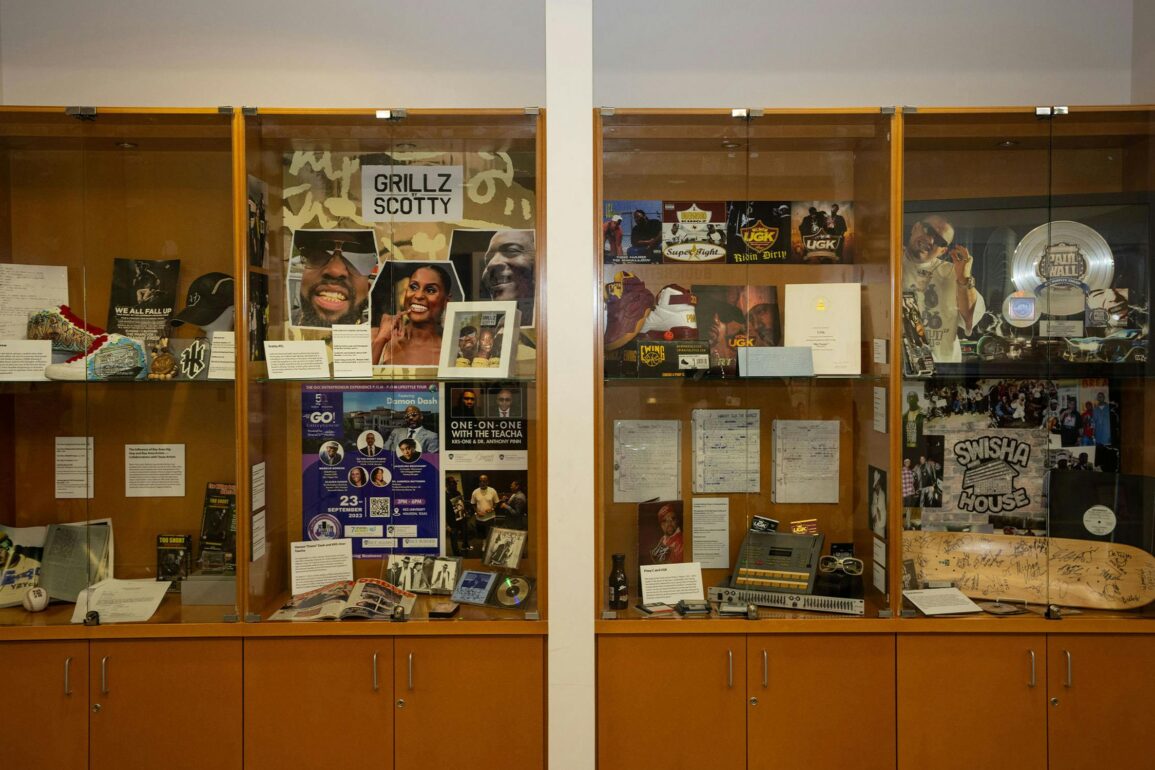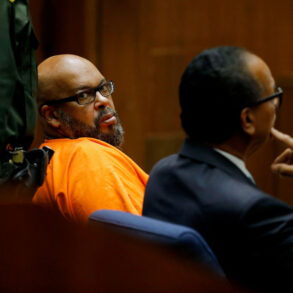Artifacts From Hip-hop History Are on Display in Houston
The “Straight Flexin’, No Plexin’ ” exhibit demonstrates how the city and the culture became inextricably linked.
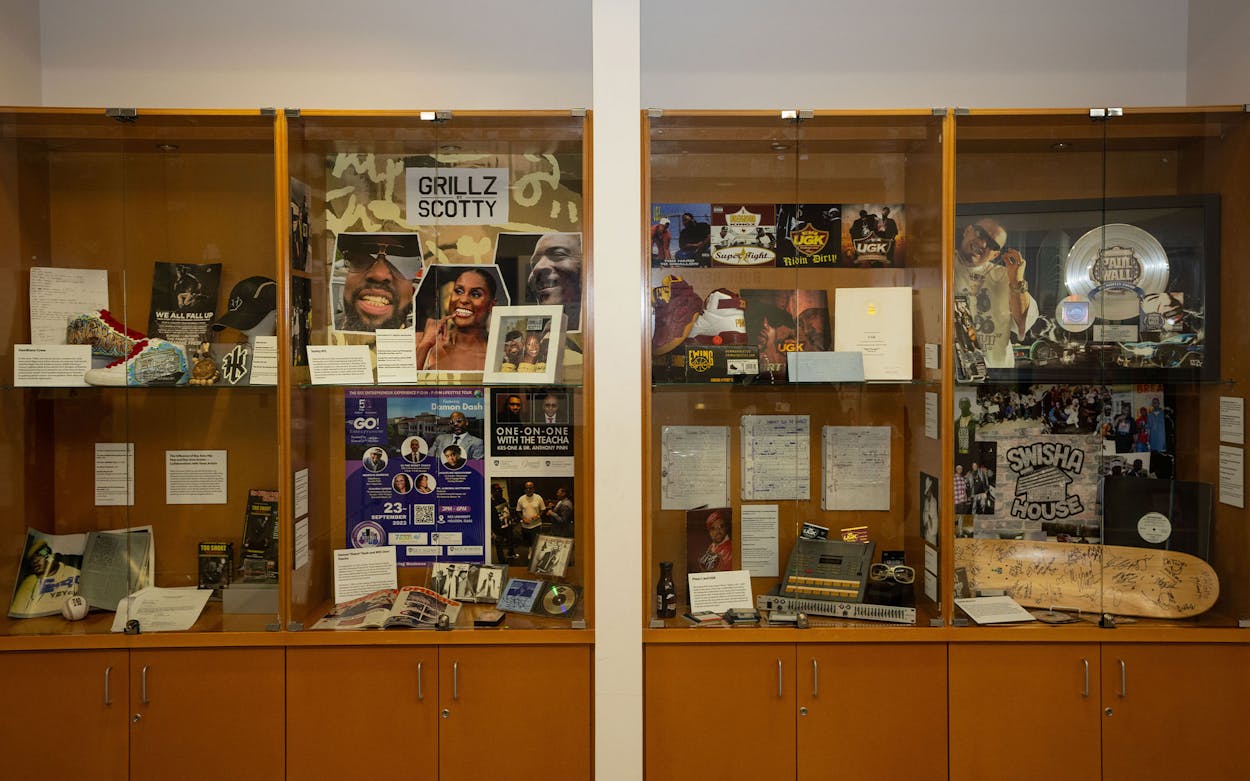
Courtesy of Awakened Visions Media
Houston’s role in hip-hop history stretches back more than forty years, to the day in 1981 when a student named Lester “Sir” Pace defied the bosses at Texas Southern University’s KTSU during a shift on the teen-friendly Kidz Jamm broadcast by playing hip-hop records on a program previously known for pop and R&B. From there, the ties between the city and the culture only grew: the founding of Rap-A-Lot Records, in 1986; DJ Screw’s pioneering of the slowed-down “chopped and screwed” mixes, in the early 1990s; and the Geto Boys selling a million copies of the record with “Mind Playing Tricks on Me” by 1992, were early milestones in the city that became a tentpole in the world of hip-hop. Now, in 2024, the idea that there was ever a time when Houston wasn’t one of the most important places in hip-hop culture seems almost far-fetched.
A new exhibit at the Hiram Clarke Multi-Service Center, inside the Vinson Neighborhood Library—just down the block from Screwed Up Records & Tapes—explores how Texas’s biggest city became inextricably linked to hip-hop culture. “Straight Flexin’, No Plexin’ ” is a collaboration between the Houston Public Library, the arts and education organization CCM Foundation and two organizations within Rice University, the Center for Engaged Research and Collaborative Learning (CERCL) and the Fondren Library.
Below, CERCL’s Co Garrett walks us through the exhibit, which runs at the library through the end of June.
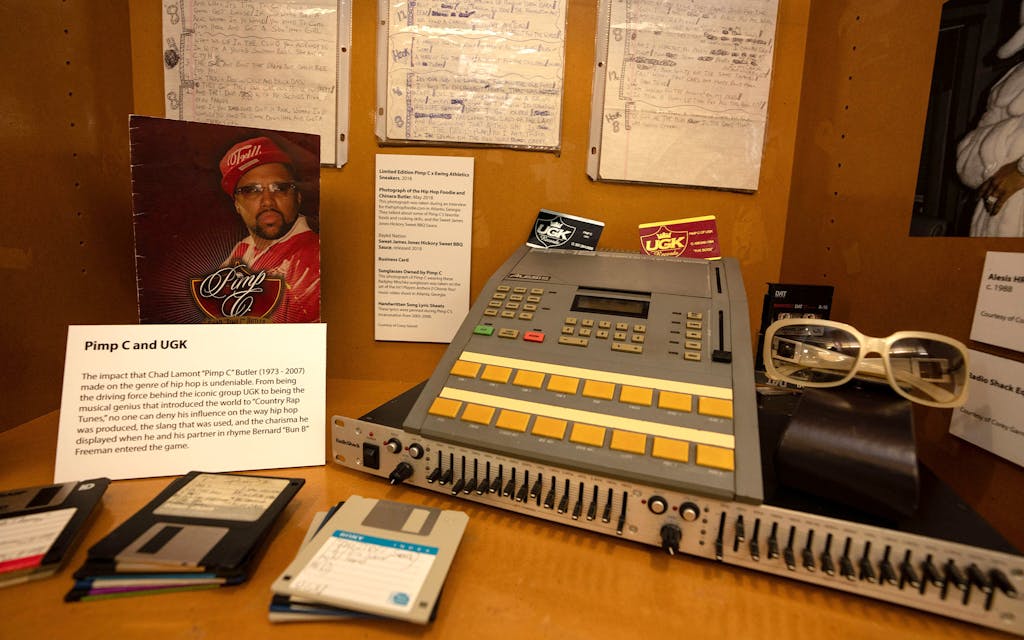
The Pimp C Display
Chad “Pimp C” Butler and Bernard “Bun B” Freeman formed UGK in 1987, and the duo soon went on to be a major part of what introduced the Houston hip-hop sound to the rest of the world. Pimp C died of an accidental overdose in 2007, and his widow, Chinara Butler, lent a number of pieces to the exhibit.
“The three lyric sheets that are displayed were all written during Pimp C’s incarceration [on an aggravated assault charge] around 2002,” Garrett says. “These songs were not yet recorded. They were definitely in the chamber waiting to be shot off at any moment. Chinara Butler was gracious enough to allow us to display these three sheet lyrics, as well as the obituary that you see listed next to the HR-16 Alesis drum machine and the equalizer that were part of his studio equipment. If you were ever able to watch any interview with [rapper and producer] David Banner speaking about Pimp C, David Banner speaks about how he was able to help Pimp C learn how to work the drum machine while he was incarcerated, by sending him actual pictures of the sequencing, and how he did that. He was able to take pictures and send them to Pimp C to stay on top of his game while locked up.
“There are some floppy disks displayed along with this equipment because floppy disks were used to store music back in the nineties. What’s good about this is that one of the floppy disks in the display actually has the sequencing for the title song off of their Dirty Money album. Those are displayed along with some DAT tapes. And the sunglasses he wore in the ‘International Players Anthem’ video are displayed as well.”
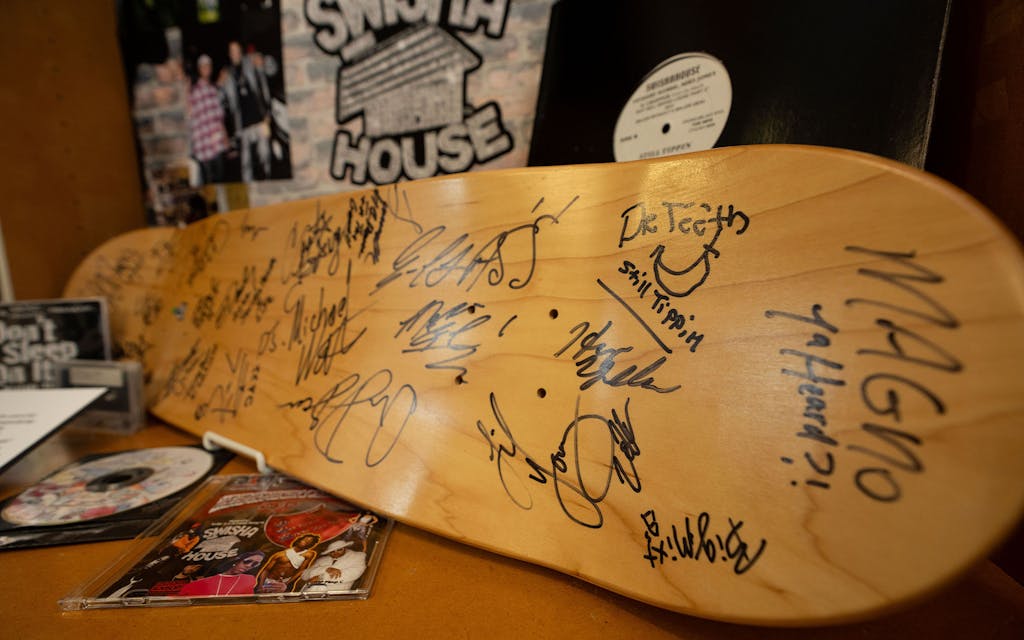


The Swishahouse Display
By the early aughts, the center of gravity in Houston hip-hop had shifted to the record label Swishahouse, which had massive hits from artists such as Chamillionaire, Mike Jones, Slim Thug, and Paul Wall. The fourth cabinet in the main display contains artifacts from the collective’s archives.
“The piece of wood is actually a skateboard. Swishahouse did a collab with Alias skateboards to release a limited edition of a skateboard. Of course, the ‘Still Tippin’’ twelve-inch vinyl record [by Mike Jones, Slim Thug, and Paul Wall] is displayed as well.
“The photos are from a one-night-only exhibit we did in October of 2022 in Houston of previously unreleased photos that Mike Frost took of the label throughout the time he was doing photography and graphic design for Swishahouse. During that exhibit, we were able to get all of the Swishahouse members who were there to sign the skateboard, so that’s pretty dope. There’s also one of the actual Swishahouse mixtapes that were created back in the nineties on display—and one of the cool parts about this is that a CD that’s being displayed, it’s one of the Swishahouse mix CDs that they released back in the day, and the artwork on it was actually hand-drawn by Chamillionaire. They were able to take those drawings and reproduce them, but this is one of the originals.”
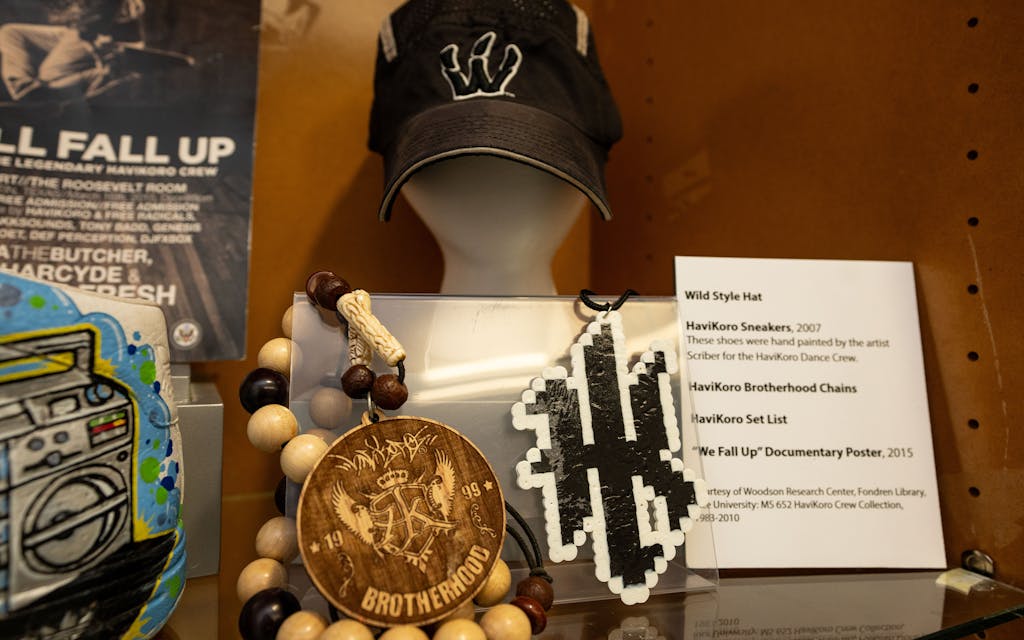

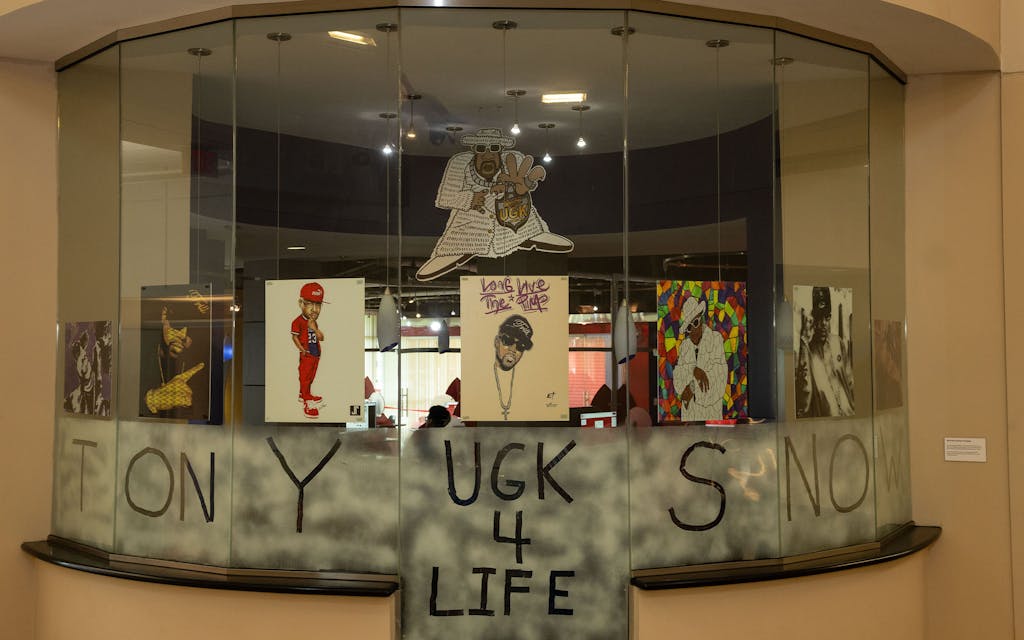
Pimp C Art Contest
“On the glass, all the pictures were submitted to the Smoke Something art contest that was held in 2014. During that time, Pimp C’s widow did the first of three Pimp C tribute shows. There was a call for submissions on her social media to let artists know there was going to be a contest, and artists submitted their Pimp C–inspired artwork. Those are some of the artworks from the actual competition.
“Then, hanging from the ceiling of that same display is a figure that was created for a clothing collaboration between UGK and Algierz clothing. They did a line of T-shirts with numerous artists in hip-hop, a lot of them from Texas, and he [owner Dan Levy] of course did a UGK line of T-shirts. They did separate lines for Bun B and Pimp C. The figure that’s hanging from the ceiling is the figure he created for Pimp C that’s on the T-shirts and the hats and everything.”
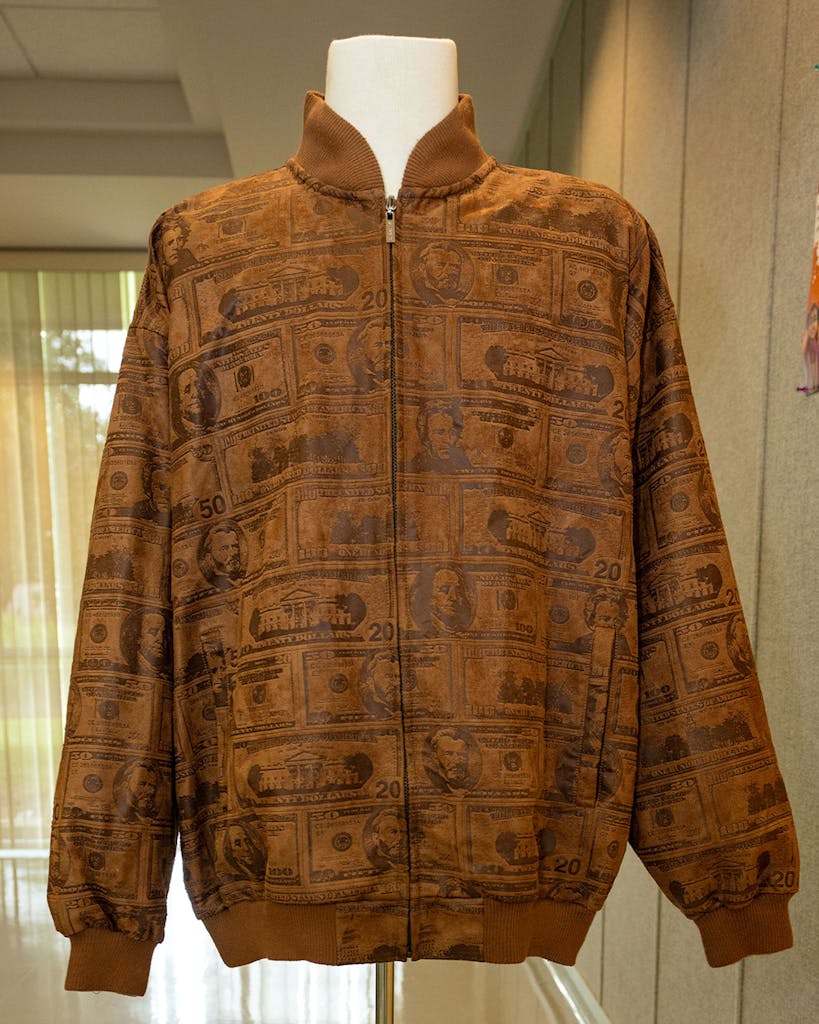


Pimp C’s Famous “Money” Jacket
“This brown jacket with the print of the dollars on it, that’s actually one of Pimp C’s jackets. And he did a photo shoot in it, and there are several photos with Pimp C in it. There are also pants that accompany the jacket with the same print. Since he has so many photos in the jacket, we thought it’d be cool to display the jacket with one of the pictures he took during that photo shoot.”



The HaviKoro Crew
Rap music is one of the core elements of hip-hop, but it’s not the only one that made its way to Houston during the culture’s formative years (the original elements are breakdancing, emceeing, DJing, and graffiti making). The music has a recorded legacy that can be accessed by anyone with a Spotify account, but the other elements of hip-hop that helped create the Houston scene are on display in the exhibit as well.
“We have items from the HaviKoro crew, which was formed by two breakdance groups down here in Houston. They joined forces back in the nineties to form this one collective, and they’ve been doing performances since their inception. They were a part of the first breakdance miniconference over at Rice, where they screened their documentary. The poster for the documentary is on display, along with some custom-made, hand-painted sneakers and the ‘Brotherhood’ chain that each member has to signify them being a part of the crew.”
This post was originally published on this site be sure to check out more of their content.



